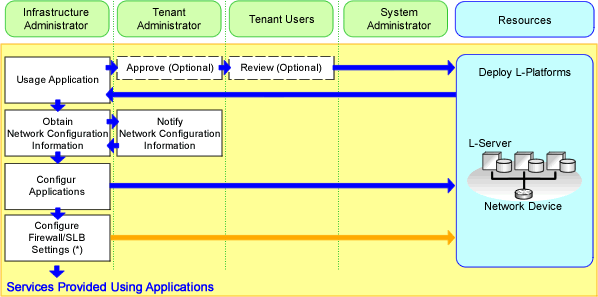This chapter provides an overview of operation, maintenance, and monitoring of Resource Orchestrator.
For additional information on the operation, maintenance, and monitoring of this product, refer to the configuration information in the "Setup Guide CE".
Flow of Service Provision Using Applications
The flow of service provision using applications in an environment where Resource Orchestrator has been installed is as shown below.
Figure 1.1 Flow of Service Provision Using Applications

* Note: Necessary when using firewalls (Firewall), server load balancers (SLB), or L2 switches.
Application for use
The tenant user applies to use an L-Platform.
For details, refer to "5.2 Subscribe to an L-Platform" in the "User's Guide for Tenant Users CE".
Approval
The tenant administrator approves the application by a tenant user to use an L-Platform.
For details, refer to "9.3 Approving an Application" in the "User's Guide for Tenant Administrators CE".
Assessment
The infrastructure administrator assesses the content of the application to use an L-Platform from the tenant administrator or tenant user.
For details, refer to "10.2 Assessing an Application" in the "User's Guide for Infrastructure Administrators CE".
Notification of settings for firewalls and server load balancers
When using a firewall or a server load balancer, the infrastructure administrator prepares a script for configuring the firewall or server load balancer.
Based on the information provided by the infrastructure administrator, the tenant administrator notifies the tenant user of the configuration information for the firewall or server load balancer.
Configure firewalls
When configuring an application on an L-Server that has been deployed on the public LAN, the tenant user needs to create a rule that enables access to that L-Server from the public LAN.
Configure applications
The tenant user performs the installation and environment settings necessary for the application to be provided as a service by the L-Server.
Confirm communication with applications
The tenant user checks that there are no problems with the applications installed on the L-Server, and that the L-Server can be accessed from the public LAN.
When a firewall has not been configured, configure one.
If there are no problems in the communication check, proceed to the next step.
If there are problems, resolve them and check communication again.
Configure server load balancers
When an L-Platform has a server load balancer deployed, the tenant user performs configuration of the server load balancer.
Check communication with server load balancers
When an L-Platform has a server load balancer deployed, test that the settings of the server load balancer are correct.
It is necessary to configure the rules for the firewall so that communication using the virtual IP address configured for the server load balancer is possible.
If there are no problems in the communication check, proceed to the next step.
If there are problems, resolve them and check communication again.
Configure firewalls
Configure address translation and firewall rules, and then test that communication with the L-Server is possible.
If the test shows no problems, configuration of the L-Platform operation environment is complete.
If there are problems, resolve them and check communication again.